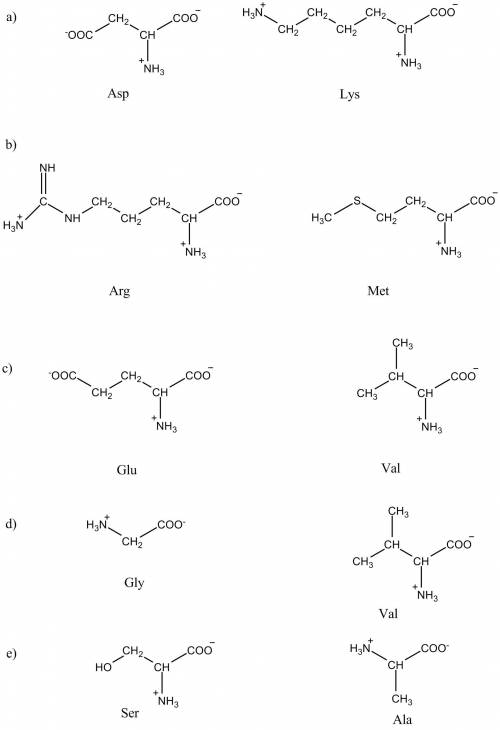
Chemistry, 10.09.2019 18:30 keirarae2005
1. separation of amino acids by ion-exchange chromatography. mixtures of amino acids can be analyzed by first separating the mixture into its components through ion-exchange chromatography. amino acids placed on a cation-exchange resin containing sulfate (-so3-) groups flow down the column at different rates because of two factors that influence their movement (1) ionic attraction between the sulfonate residues on the column and positively charged functional groups on the amino acids, and (2) hydrophobic interactions between amino acid side chains and the strongly hydrophobic backbone of the polystyrene resin. for each pair of amino acids listed, determine which will be eluted first from the cation-exchange column by a ph 7.0 buffer.
a.) asp and lys
b.) arg and met
c.) glu and val
d.) gly and val
e.) ser and ala

Answers: 2


Another question on Chemistry

Chemistry, 22.06.2019 05:30
A3.37-mg sample of protein was chemically digested to convert its nitrogen into ammonia and then diluted to 100.0 ml. then 10.0 ml of this solution was placed in a 50-ml volumetric flask and treated with 5 ml of phenol solution plus 2 ml of sodium hypochlorite solution. the sample was diluted to 50.0 ml, and the absorbance at 625 nm was measured in a 1.00-cm cuvette and found to be 0.486. for reference, a standard solution was prepared from 10.0 mg of nh4cl (molar mass = 53.49 grams/mole) dissolved in 1.00 l of water. then 10.0 ml of this standard was placed in a 50-ml volumetric flask, treated in the same manner as the unknown, and the absorbance found to be 0.323. finally, a reagent blank was prepared using distilled water in place of unknown, it was treated in the same manner as the unknown, and the absorbance found to be 0.076. calculate the weight percent of nitrogen in the protein.
Answers: 1

Chemistry, 22.06.2019 15:30
Light waves can move through , but they travel fastest when they move through a(n) .
Answers: 1

Chemistry, 23.06.2019 12:30
An atom holds 7 electrons. use orbital notation to model the probable location of its electrons. an atom hold 22 electrons. use orbital notation to model the probable location of its electrons. an atom holds 17 electrons. use orbital notation to model the probable location of its electrons.
Answers: 1

Chemistry, 23.06.2019 15:00
For part 1, describe the changes in the colors of the well, if any, as you go from well 1 to well 9—that is, as you go from the well with the least copper(ii) nitrate to the well with the most copper(ii) nitrate. which wells had the most distinct precipitate? for part 2, describe the changes in the colors of the well, if any, as you go from well 1 to well 9—that is, as you go from the well with the least iron(ii) sulfate to the well with the most iron(ii) sulfate. which wells had the most distinct precipitate? for part 3, describe the changes in the colors of the well, if any, as you go from well 1 to well 9—that is, as you go from the well with the least iron(iii) nitrate to the well with the most iron(iii) nitrate. which wells had the most distinct precipitate?
Answers: 3
You know the right answer?
1. separation of amino acids by ion-exchange chromatography. mixtures of amino acids can be analyzed...
Questions

Mathematics, 09.12.2020 22:10




World Languages, 09.12.2020 22:10



Mathematics, 09.12.2020 22:10


Mathematics, 09.12.2020 22:10

Biology, 09.12.2020 22:10


History, 09.12.2020 22:10

Social Studies, 09.12.2020 22:10

Arts, 09.12.2020 22:10


Mathematics, 09.12.2020 22:10

Mathematics, 09.12.2020 22:10


Social Studies, 09.12.2020 22:10




